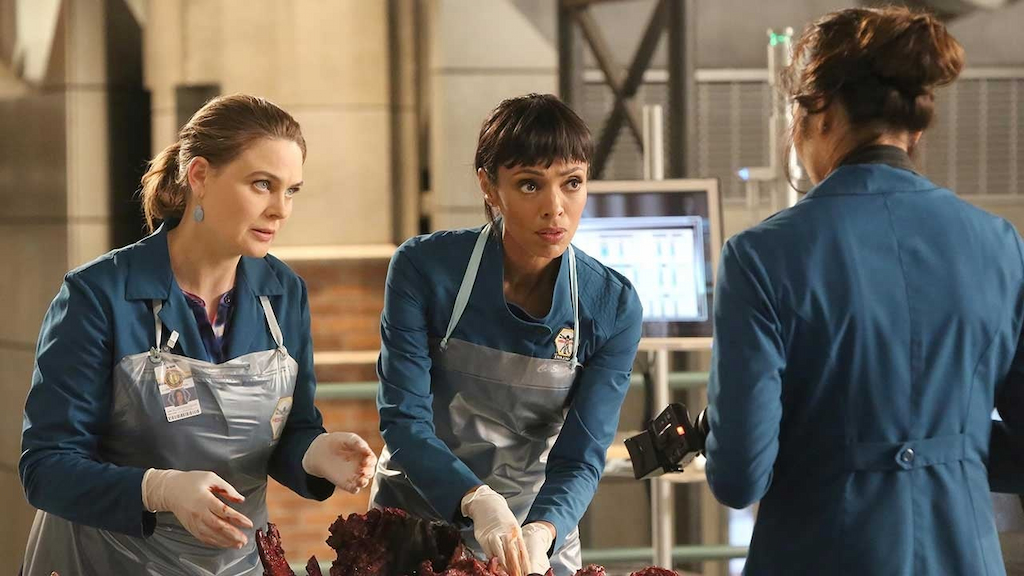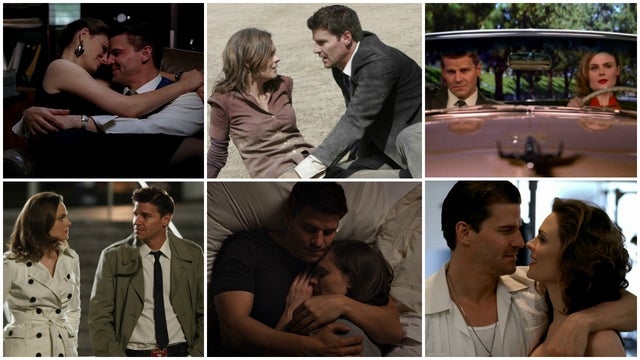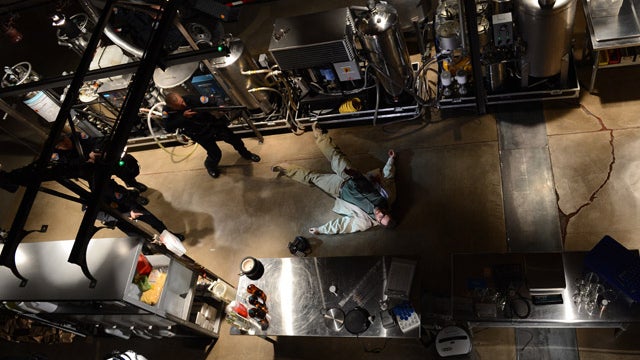Fox's longest-running scripted drama says goodbye on Tuesday, with a finale that pays tribute to the characters that made it great.
When Bones signs off on Tuesday night, after 12 seasons on Fox, it will do so as the network’s longest-running scripted drama, having solved -- according to finale promos -- 275 cases in 246 episodes. And that prolific conviction rate may not even be the most impressive thing that the series accomplished.
Because Bones -- which was based on the life and works of real-life forensic anthropologist Kathy Reichs -- did more than just stay on the air, leapfrogging more than 20 different time slots in its 12-year run. In a television landscape populated with morose antiheroes and sarcastic protagonists that often poke fun at the earnestness of cops-and-science procedurals like Bones, sometimes directly by name (see: American Dad, Bojack Horseman, Bob’s Burgers and more), the show was a champion of justice and evidence, science and guts, “brains and heart.” It told new stories every week, while at the same time unfolding its central characters little by little, making them feel like family and bringing fans along for the ride.
“This [show] was different, it was traditional,” said executive producer Stephen Nathan in the Fox-produced “Back to the Lab: A Bones Retrospective” special. “It was much more about a belief in the human spirit, about the goodness of man.”
“It’s a redemptive show,” added EP Jonathan Collier. “You can watch it, you can feel better about yourself, you can feel better about life, you can do it in an honest way.”
RELATED: 'Bones' Says Goodbye After 12 Seasons: A Look Back at Brennan and Booth's 22 Best Episodes
Procedurals may be nothing new on network TV, but a show like Bones -- which passed the Bechdel test, bested the Moonlighting curse, and found its heart in a stellar cast, all while still solving grisly murders every week -- was truly something special.
The Bechdel Test
Bones may be, at its heart, a story about forensic anthropologist Dr. Temperance Brennan (Emily Deschanel) and her personal and professional journey alongside FBI Special Agent Seeley Booth (David Boreanaz), but at the core of the Jeffersonian Institute brain trust from the very beginning were three dynamic females, a rarity on any TV show, let alone a network procedural.
“I’ve always pointed out that I love the fact that the female characters on the show have bigger offices than the men,” Deschanel told ET in a phone interview prior to the finale. “They’re all intelligent, strong, successful women who are not ashamed to be who they are and to tell you they’re brilliant and to be successful in those fields.”
Brennan was the center -- the “Bones,” despite her protestations of the nickname -- a brilliant, hard-nosed scientist who suffered no fools and wasn’t afraid of offending or maligning anyone in the name of empiricism. She came by her guardedness honestly, though, and Deschanel allowed the flashes of vulnerability underneath to shine through as the series progressed and she found love with Booth and a family in the team at the Jeffersonian.
But every yin needs a yang, and the anthropologist’s foil came in the form of her best friend, forensic artist and free spirit Angela Montenegro, who was as unabashed with her sagely advice as she was with her sexuality. Series star Michaela Conlin expertly tiptoed her character’s line between Willow Rosenberg and Phoebe Buffay, and Angela held her own amongst more decorated colleagues, often speaking up as the voice of reason when the science-minded team was struggling to see the bigger picture.
“The Brennan and Angela dynamic was fun because they’re so different,” explained Bones co-executive producer Karine Rosenthal. “It was lovely to see two people who handle situations differently still go to each other for advice.”
"Hart Hanson [the show's creator and executive producer] wrote these very complicated, full people," Conlin added of her character. "I'm thankful for that, because it could have been just a best friend role. I think he allowed us to do a lot more through the years."
EXCLUSIVE: Emily Deschanel and David Boreanaz Reveal What They're Going to Miss Most About 'Bones'
And, with apologies to Jonathan Adams, Heavy D and all the other season one players that disappeared at the start of the show’s sophomore run, Bones wasn’t fully itself until Tamara Taylor came on board on season two. Her no-nonsense cop-turned-coroner-turned-Jeffersonian forensic director Camille Saroyan butted heads with Brennan from the start, but almost always in a strictly professional capacity -- even when she struck up an old fling with Booth.
“I think Hart set that up pretty early on, and I think it was pretty rare and ahead of its time,” Taylor said of the show’s core group. “Female friendships, especially, can get snarky and strange and there’s just a really cool, strong bond [between them].”
Bones’ three central female characters, two of them women of color, did everything the men on the show did, and then some. They dressed to the nines but still got their hands dirty, found meaning in their work as much as their personal life, challenged authority and were heard, and most importantly, heroically helped put away the bad guys.
Plus, they passed the Bechdel test often -- in conversations with each other and some of the show’s supporting female characters: beloved prosecutor Caroline Julian (Patricia Belcher), and Jeffersonian interns Daisy Wick (Carla Gallo) and Jessica Warren (Laura Spencer) -- thanks in no small part to the Bones writing staff which is, among its most frequently credited episode scribes, about 50 percent female.
“I’m just glad that we had a show with strong females and women in STEM,” Deschanel reflected. “My favorite thing to hear is a young girl saying that she wants to become a scientist because of watching the show. That, to me, makes the show worth it.”
RELATED: 'Bones' Stars and Creator Address 'Possible' Revival Plans
The Moonlighting Curse
While Hanson has often admitted that he wanted to keep Booth and Brennan apart romantically for “as long as possible,” the central couple's magnetism never faltered after they made things official. In fact, it’s easy to argue that the pair's relationship -- which followed a uniquely mercurial trajectory from first kiss to happy ever after -- only got more dynamic as they grew more domestic, thanks to the wealth of conflict in the fundamental differences between Brennan’s rational side and Booth’s faith.
“They were so diametrically opposed to each other that we could just keep playing that and playing that, but knowing the whole time that they were getting closer and closer,” Nathan said of the pair’s will-they-or-won’t-they relationship in early seasons.
From start to finish, Hanson insists, the success of Brennan and Booth’s long-lasting relationship is a testament to Deschanel and Boreanaz’s chemistry and hard work.
“They're fantastic friends. They took care of each other off-screen. They were very sibling-esque offscreen and behind the scenes,” he recently told TV Insider. “That's the other reason we went forever: You've heard all those stories of what happens between co-leads on series; they tend to really dislike each other. Ours didn't.”
GALLERY: Your Favorite WB Stars: Where Are They Now?
The Casting Carousel
“If I’m going to say the show is about one thing, it’s about the definition of family, and what that means for different people,” Rosenthal mused in the “Back to the Lab” retrospective.
Bones found that family in its stellar cast, which started with Deschanel and Boreanaz, but extended to entirety of the “Squint Squad,” from Conlin and Taylor to T.J. Thyne’s impressive series-long run as the Jeffersonian’s resident “bug boy,” Dr. Jack Hodgins, and Eric Millegan as Brennan’s early assistant, Zack Addy.
After Zack’s departure at the end of season three, in came the “squinterns,” a group of student assistants that rotated every week.
“The initial thing was, there was so much science jargon, wouldn’t it be great to have more characters to help with that? We’d have these rotating characters all trying to do well for the Brennan character,” recalled executive producer Barry Josephson of creating the dynamic group. “And each one that they created, season in and season out, was just so wonderful, and the actors that came and did those roles were just brilliant.”
It was a game-changing decision, as the lab wouldn't have been the same without Daisy, Jessica, Clark Edison (Eugene Byrd), Wendell Bray (Michael Grant Terry), Arastoo Vaziri (Pej Vahdat), Colin Fisher (Joel David Moore), Vincent Nigel-Murray (Ryan Cartwright), Finn Abernathy (Luke Kleintank), Rodolfo Fuentes (Ignacio Serricchio), Oliver Wells (Brian Klugman) and more.
And the reverse is true as well -- Cam found love with Arastoo, Daisy’s tragic romance with FBI psychologist Lance Sweets (John Francis Daley) ended with the birth of a son, Brennan and Booth's first real hookup happened in the storm of grief following Vincent's death -- at the end of the day, the squinterns shaped the Jeffersonian as much as it shaped them.
The lab wasn’t the only place that the Bones team found family. The FBI offices provided their own cast of beloved characters, from “baby duck” Sweets (R.I.P.) to everyone’s favorite Booth and Brennan fangirl, Caroline. In later seasons, John Boyd’s Agent James Aubrey stepped in as Booth’s right-hand man, becoming “Uncle Aubrey” to little Christine and Hank.
Bones even made a meal out of unconventional stunt casting, turning appearances from Cyndi Lauper and Billy Gibbons into recurring roles that had a genuine impact on the show’s central characters.
“It was always about the characters first,” explained Nathan, “and the case was the foundation on which we built those relationships.”
WATCH: 'Bones' 200th Episode: David Boreanaz & Emily Deschanel Spill Everything You Need to Know!
The Very Special Episode
Within the show’s 245 episodes, Bones had a lot of time to tackle the issues -- everything from government corruption to animal trafficking to medical marijuana -- but often did so in a fresh and distinctive way, putting a twist on the classic procedural structure through characters and storytelling devices.
In a season eight episode, the entire story is told from the point of view of the skull that the team is examining, showing a unique perspective at the usually stoic central characters. In season five, they recreated the JFK assassination after being forced to investigate mysterious remains from a shadowy government organization. Even the show’s “stuck-in-an-elevator” episode is a powerful one, leading to a confession from Booth about his troubled relationship with his father.
The show also tackled prejudice and social issues in both micro and macro storylines. Arastoo begins his tenure as an intern with a heavy accent, until one day it slips and he is forced to reveal that he was putting on the affectation to make his Muslim faith more palatable to his Jeffersonian coworkers, a subtler shade of Islamophobia not often acknowledged in film and television. Later in the series, Arastoo’s romance with Cam unfolds the complexities of his character, revealing his status as a political exile, his passion for poetry and his complicated relationship with his traditional parents.
Cam herself shouldered a fair share of heavy subject matter in the series’ run, confronting racial issues -- “We don't have a caste system in America,” Daisy innocuously observes in one episode, to which the pathologist replies, “You wanna say that to my face?” -- adopting the daughter of her late boyfriend after the team investigates his murder, and planning the funerals of far too many friends and co-workers.
And in 2012, the show tackled 9/11 by acknowledging the reality that a group of elite scientists who work with the dead would have been called upon in the weeks and months following the terror attacks. Cam and Brennan share tearful tales from their traumatic time in the wreckage, and, as the younger interns work to solve the mystery of a homeless man who was injured at the Pentagon on that fateful day, they share their own stories with each other. Wendell’s uncle was a New York City firefighter. Arastoo was at morning prayers. It was a powerful episode that showed one of Bones’ greatest strengths: drawing human stories from both the living and the dead.
TV: 'Bones' Sends Off Old Friends and Brings Back a Big Bad in Explosive Penultimate Episode
The Sunny Side
While the show dealt with death on a more-than-regular basis and handled tough topics with care, there was always still time for fun. (Remember when Stewie from Family Guy popped up in Booth’s hallucination?)
From undercover missions at the circus or an Old West shooting competition, to the Alfred Hitchcock-inspired 200th episode, to more standard case-of-the-week crack-ups -- seriously, Stewie was in an episode -- Bones was never afraid to find the laughs.
“There’s a lighthearted quality, there’s humor involved in the show. Some episodes are fully farces,” said Deschanel in a Fox finale promotion, before she and Boreanaz laughingly dubbed the show a “crimedy.”
The truest testament to Bones, perhaps, is that even after more than a decade together, the cast and crew seem genuinely sad to be saying goodbye.
“I feel like we all became who we are doing this show,” Conlin said in the "Back to the Lab" special, tearing up.
“It’s wonderful to be creative with people that you think are inspiring and beautiful and evolving and surprising,” Taylor agreed. “It’s just a pretty awesome ride. It’s more than a gal could ask for.”
EXCLUSIVE: Emily Deschanel and David Boreanaz Reveal What They're Going to Miss Most About 'Bones'


